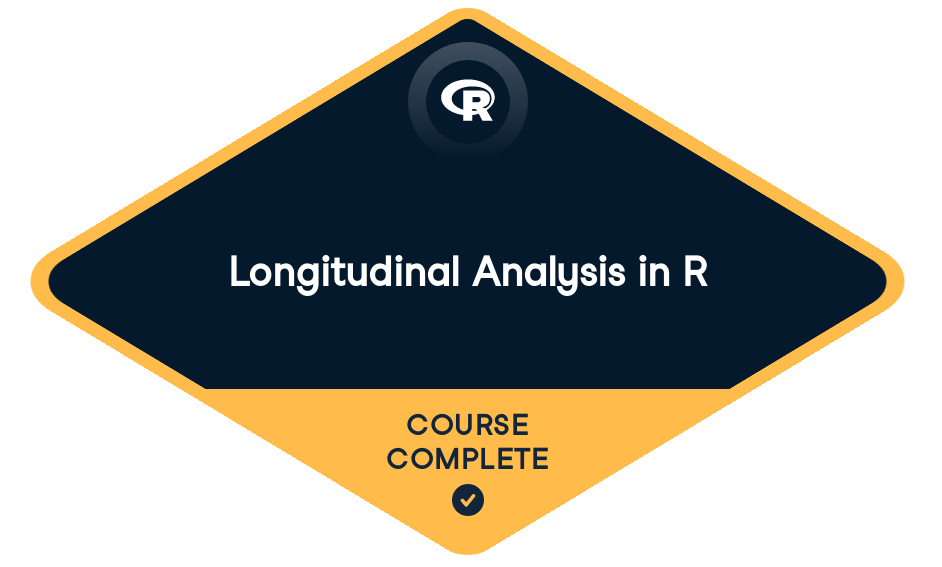
Loved by learners at thousands of companies
Course Description
What is longitudinal data and how can you analyze it? Here you will learn all about this kind of data and the descriptive analyses that can be used to explore it! You will also learn to model continuous and binary outcome variables. Linear mixed effects models will be used as a modern approach to modeling this kind of data, taking into account the correlated nature of it. For binary outcomes, generalized estimating equations will be introduced as an alternative to the generalized linear mixed models. Visualizations are used throughout the course to interpret model results and strategies for model selection are also explored. Along the way, you will use data from a number of longitudinal studies, including the Madras and Calcium datasets.
Training 2 or more people?
Get your team access to the full DataCamp platform, including all the features.- 1
Introduction to Longitudinal Data
FreeThis chapter introduces the user to longitudinal data. Exploration of what is and what isn't longitudinal data, exploration of the dependent data structure, and other numeric summaries of the data will be covered in this chapter.
- 2
Modeling Continuous Longitudinal Outcomes
Chapter 2 will model continuous longitudinal outcomes with lme4. These observed score mixed models are common in the analysis of longitudinal data.
Longitudinal analysis for continuous outcomes50 xpVisualizing individual raw trajectories100 xpFirst lme4 model100 xpRestructure time variable100 xpDifference in time metrics50 xpAddition of random slope terms50 xpFit a random slope model100 xpModel comparison100 xpBest fitting model50 xpVisualize and Interpret Output50 xpVisualize random intercepts100 xpVisualize random slopes100 xpModel implied correlations100 xp - 3
Add fixed predictor variables
This chapter will further explore adding additional predictors to the longitudinal model. These predictors, referred to as fixed effects, allow different trajectories based on variable characteristics.
Adding Predictors50 xpAdd Additional Predictor Variables100 xpAggregate and visualize model results100 xpEffect of Group Variable50 xpAdding Predictors - Interactions50 xpAdd Interactions100 xpVisualize Model Residuals100 xpVisualize random effects100 xpModel Comparisons and Explained Variance50 xpModel Comparisons100 xpExplained Variance100 xpBest fitting model50 xp - 4
Modeling Longitudinal Dichotomous Outcomes
This chapter will shift from continuous to binary outcomes. Binary outcomes are ones in which the outcome are in two categories. Special considerations for this outcome are needed to appropriately model the data and receive valid statistical results.
Exploring and Modeling Dichotomous Outcomes50 xpHow many have symptoms?100 xpFitting first glmer model100 xpAdd predictor variables100 xpGeneralized Estimating Equations50 xpFirst GEE model100 xpAdd predictors to GEE100 xpModel Selection50 xpFitting a model with a working correlation matrix100 xpSelect working correlation matrix50 xpInterpreting and Visualizing Model Results50 xpVisualize GLMM results100 xpVisualize GEE results100 xpCompare GEE and GLMM100 xpVisualize aggregate trends100 xp
Training 2 or more people?
Get your team access to the full DataCamp platform, including all the features.collaborators


prerequisites
Working with Data in the TidyverseDataCamp Content Creator
See MoreCourse Instructor
DataCamp offers interactive R, Python, Spreadsheets, SQL and shell courses. All on topics in data science, statistics, and machine learning. Learn from a team of expert teachers in the comfort of your browser with video lessons and fun coding challenges and projects.
Join over 18 million learners and start Longitudinal Analysis in R today!
Create Your Free Account
or
By continuing, you accept our Terms of Use, our Privacy Policy and that your data is stored in the USA.